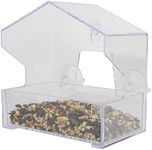Buying Guide for the Best Window Bird Feeders
Choosing a window bird feeder is a fun way to bring nature closer to your home and enjoy watching birds up close. The right feeder can attract a variety of birds and provide hours of entertainment. When picking a window bird feeder, it's important to consider how it attaches to your window, the type of birds you want to attract, and how easy it is to maintain. Understanding the key features will help you select a feeder that fits your needs and your window setup.Mounting MethodThe mounting method refers to how the feeder attaches to your window, usually with suction cups or adhesive strips. This is important because it affects how securely the feeder stays in place, especially in different weather conditions. Suction cups are common and easy to install, but their strength can vary. Some feeders have larger or multiple suction cups for better grip, while others use adhesive strips for a more permanent hold. If you live in an area with strong winds or want to feed larger birds, look for feeders with strong, multiple suction cups. For easy removal and cleaning, suction cups are usually the best choice.
Feeder Size and CapacityFeeder size and capacity refer to how much seed the feeder can hold and how much space it provides for birds. This matters because a larger feeder can attract more or bigger birds and requires less frequent refilling, while a smaller feeder is easier to clean and may be better for small windows. If you want to attract a variety of birds or have a busy feeding spot, choose a larger feeder. For limited space or if you prefer to refill and clean more often, a smaller feeder is suitable.
Material and DurabilityThe material of the feeder, often clear plastic or acrylic, affects how well you can see the birds and how long the feeder will last. Durable, UV-resistant materials are important because they withstand sun exposure and weather without cracking or becoming cloudy. Thicker materials are generally more robust and last longer. If you want a long-lasting feeder that stays clear for better viewing, look for one made from high-quality, UV-resistant acrylic.
Ease of CleaningEase of cleaning refers to how simple it is to remove old seed and wash the feeder. This is important for the health of the birds and to prevent mold or bacteria buildup. Some feeders have removable trays or wide openings that make cleaning easier. If you want to keep maintenance simple and ensure a healthy feeding environment, choose a feeder with parts that are easy to take apart and wash.
Seed Type CompatibilitySeed type compatibility means what kinds of bird food the feeder can hold, such as mixed seed, sunflower seeds, or suet. This matters because different birds prefer different foods, and some feeders are designed for specific types. If you want to attract a wide range of birds, pick a feeder that can hold various seed types. If you have a favorite bird species in mind, check what seeds they like and make sure the feeder is suitable for that type.
Protection from Weather and SquirrelsSome feeders have features like overhangs or drainage holes to protect seeds from rain and snow, and some are designed to deter squirrels. This is important to keep the seed dry and fresh, and to prevent unwanted visitors. If your area gets a lot of rain or you have squirrels nearby, look for feeders with weather protection and squirrel-resistant designs.















